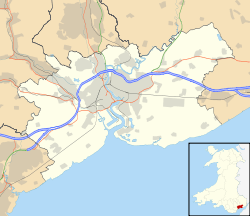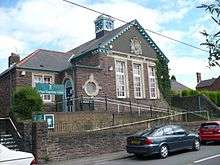Rogerstone
Rogerstone (Welsh: Tŷ du, meaning "Black house") is a large village, ward and community (parish) of the city of Newport, southeastern Wales. The area is governed by the Newport City Council. The village falls within the ancient parish of Bassaleg and historic county of Monmouthshire.
| Rogerstone | |
|---|---|
 Rogerstone Location within Newport | |
| Population | 10,158 (2011 census)[1] |
| OS grid reference | ST271885 |
| Principal area | |
| Country | Wales |
| Sovereign state | United Kingdom |
| Post town | NEWPORT |
| Postcode district | NP10 |
| Dialling code | 01633 |
| Police | Gwent |
| Fire | South Wales |
| Ambulance | Welsh |
| UK Parliament | |

The parish lies at the gateway to the Sirhowy valley, to the north of Newport on the eastern side of the Ebbw River.[2] It is bounded by the M4 motorway to the south, the Ebbw River to the west, the Henllys vale to the east and the city boundary with Caerphilly county borough to the north.
Rogerstone railway station is on the Ebbw Valley Railway. It opened on 6 February 2008 and links Ebbw Vale to Cardiff Central via Rogerstone.
History
The original settlement dates back to Norman times when Rogerstone Castle was built in the early part of the 12th century. The name is said to originate from Roger de Haia, the Norman Lord who was responsible for the building of the castle, the remains of which are reduced to a low bush and tree covered motte opposite Criddle's garage on the lower section of Tregwilym Road. The Welsh name for Rogerstone "Tŷ Du" translates to English as "Black House", though no one is entirely sure why it has this name.
The larger parish of Rogerstone started as two distinct settlements of Tregwilym and Tydu, Tregwilym taking its name from the land owner, William de Berkerolles. These hamlets remained predominantly rural until the advent of the industrial revolution. The population grew in response to the tin, iron and aluminium industries which flourished near the South Wales coalfield. At one point, the village boasted the longest aluminium rolling mill in Western Europe and one of the largest marshalling yards on the Great Western Railway network.
The village played host to John Frost and his fellow Chartists on their historical march from the valleys to Newport, the Welsh Oak public house just north of the parish being one of the key meeting points for the protestors before they set off through the parish towards the Westgate Hotel and turmoil.
The parish sits astride the Crumlin branch of the Monmouthshire Canal and plays host to the Fourteen Locks.[3] The canal opened in 1798 but was dogged by water supply problems and competition from the railways and by 1930, it had finally succumbed and has since fallen into disrepair.
Rogerstone Library is part of Newport City Council's library service, and is officially titled Rogerstone Library and Information Centre. The building was opened in 1905 as a Carnegie Library. Newport has a second Carnegie Library on Corporation Road.
Rogerstone power station was commissioned in 1958 by the Central Electricity Generating Board, after only three years work on the site.[4] It comprised two C.A. Parsons 60 MW turbo-alternators with a net electricity output capability of 114 MW.[5] The Babcock & Wilcox coal-fired pulverised fuel boilers produced 138 kg/s of steam delivered to the turbines at 62.1 bar and 482°C.[5] Cooling for the station was by water from the River Ebbw and two reinforced concrete cooling towers each with a capacity of 2.25 million gallons per hour (2.84 m3/s). There was a single chimney. It was the first station in the UK to use aluminium cladding.[4]
The generating capacity and electricity output from the station was as follows.[6][5][7][8]
| Year | Capacity MW | Output GWh |
|---|---|---|
| 1958 | 112 | 221.396 |
| 1960 | 120 | 846.663 |
| 1961 | 120 | 910.247 |
| 1962 | 120 | 840.604 |
| 1963 | 120 | 664.277 |
| 1972 | 126 | 501.896 |
| 1979 | 120 | 307.899 |
| 1981 | 120 | 211.666 |
| 1982 | 120 | 260.918 |
The station was decommissioned in the late 1980s; and the boiler house, cooling towers and chimney were demolished in 1991.[9]
Modern-day Rogerstone
The designation of the Rogerstone section of the canal as part of the National Cycle Network (route 47) and more recent efforts to restore parts of the canal have made the site a popular tourist attraction. The restoration of the locks of the canal has already cost millions, with only a few locks completed so far. Funding for this work has been provided by the Heritage Lottery Fund. The rubbish and mud lying at the bottom of the locks is being removed and the old stones that used to lie at the bottom of the locks will now be removed and replaced. The site houses the 14 Locks Canal Centre which was the subject of an arson attack in 2012 which ruined the inside of the centre. It has now been fully refurbished and is open to the public.
Rogerstone was traditionally an industrial, working-class village, but recent expensive housing developments such as Foxgloves, on the site of the former power station, has added more than 1,000 dwellings and an ever-increasing middle-class population. This has been influenced by the improved transport links.
In 2005, Warburtons opened a new bakery in the village, to supply bakery products across South Wales. However, after the financial crisis of 2007–2008, in 2010, the company announced the closure of the facility, and the loss of 140 jobs. The plant was later bought by local family owned Brace's Bakery.[10]
There are four primary schools within Rogerstone; Rogerstone Primary, Mount Pleasant Primary, High Cross Primary and Jubilee Park Primary.
References
- "Newport ward 2011". Retrieved 5 April 2015.
- Grazing, above Rogerstone:: OS grid ST2788 :: Geograph Britain and Ireland - photograph every grid square!
- Fourteen Locks Canal Centre:: OS grid ST2788 :: Geograph Britain and Ireland - photograph every grid square!
- The Electricity Council (1987). Electricity Supply in the United Kingdom: a Chronology. London: The Electricity Council. p. 74. ISBN 085188105X.
- Central Electricity Generating Board (1981). CEGB Statistical Yearbook 1980-81. London: CEGB. p. 7.
- Garrett, Frederick C. (ed) (1959). Garcke's Manual of Electricity Supply vol.56. London: Electrical Press. pp. A-89, A-132.CS1 maint: extra text: authors list (link)
- CEGB (1972). CEGB Statistical Yearbook 1972. London: CEGB. p. 11.
- GEGB Annual report and accounts, various years
- "Rogerstone power station". Coflein. Retrieved 4 February 2020.
- "Brace's Confirms Purchase of Warburtons' Site At Rogerstone, Newport". Brace's Bakery. 14 February 2011. Retrieved 16 April 2011.
